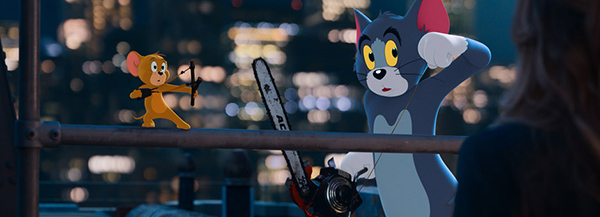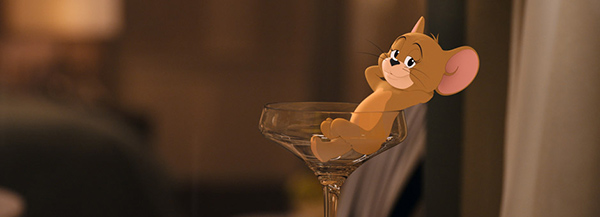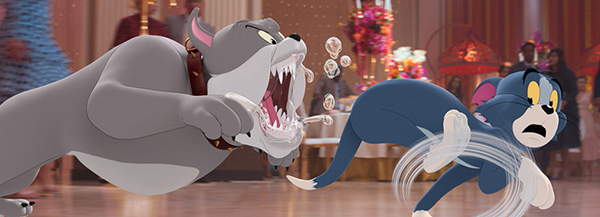
The colour grade for the new ‘Tom and Jerry’ movie, featuring animated characters Tom and Jerry in a live action setting, was completed in two separate locations on two continents. Colourist John Daro at Warner Bros Post Production Creative Services said that grading a hybrid live-action/animated film was a bit like working on two distinct movies at once.
“You have the live action film with its grade, and then the characters are added on top,” he said. “You have to keep the characters separate so they don’t take on the grades from the plate. Next, you grade the characters to make them consistent from shot to shot, while taking into account the various lighting conditions and local colour from the live action plate.”
HDR grading for the project started immediately after the theatrical edit was locked in November 2020. They had a tight turnaround since the picture would be available simultaneously in theatres and on HBO Max, and completed the deliverables in early January 2021.
London to LA and Back Again
Remote collaborative work between London and LA was critical for the project, which made supporting and completing this project during some of the most restrictive months of the pandemic one of the most challenging aspects of finishing this film for Warner Bros. John was working on a FilmLight Baselight grading system.

“Things were looking pretty bad on the Covid front when we started the grade in early December,” said John. “The grade supervision was rotated between Director Tim Story, producer Chris DeFaria and the editor Peter Elliot since I was limited to only two creatives in the room at a time. We sent Baselight project files to DeLane Lea so that the Cinematographer Alan Stewart and VFX Supervisor Frazer Churchill could review them in London.
“Communication between editorial and VFX in Burbank and London was another key factor – all via email, Teams and phone calls. The challenge was keeping everyone’s work synchronised between two different time zones. Later on, we realised that having a 24-hour work cycle would also be one of the project’s greatest strengths.”
Workflow – VFX, Editorial, Grading
Framestore London completed the VFX shots for the show, creating numerous versions of every shot right up until delivery and, as is typical, a couple to follow up after that. Framestore received ACES AP0 EXRs and, once their work was complete, returned the same format back to us – with one key difference. “Aside from the beautiful animation, the plates also acquired a number of matte channel layers in the EXR. Each character had mattes for their body, eyes, drybrush and any props they were handling. This resulted in some extra prep prior to colour, but it paid off enormously when we started the grade,” John said.

“Conform and colour prep was completed at DeLane Lea by DI Editor Otto Rodd. While we were sleeping in LA, Otto would cut in the night’s VFX deliveries and connect all the mattes for use in the grade. Considering the number of characters and the granularity of the mattes, I can’t begin to tell you what a herculean effort this was. At the end of his day, he would send the project files for the updated reels back to LA where DI Editor Leo Ferrini would then take over while Otto slept.
“The organisation that Otto and Leo imparted onto the timeline was second to none. Each character occupied its own layer in an effort to keep the timeline nice and tidy. This layer stayed consistent throughout the whole film, even if the character was not in the shot. Tom was on layer 100, Jerry on 200, Spike on 400, and so on. In short, the number of characters and props in the film called for a lot of layers.”
Bluer Tom
The direction for the show’s look was bright, vibrant and colourful, and the look was derived mostly from Baselight’s Base Grade operator and Curves. When using Base Grade, all exposure values and pivot points are specified in aperture stops, a familiar unit that matches human perception and is straightforward for DPs to understand.
The key art was very informative to the look, and they also referenced the old cartoons. Over the years, Tom has had various looks ranging from grey to blue. “We ended up going with the bluer Tom, which helped him pop off the typically warm backgrounds. Going with the blue Tom also have him a nice contrast with the warm browns of Jerry,” John said.

“I had my pass sorted out after some initial conversations with the filmmakers, and then they came in and we spotted the reels, setting key looks for each scene,” said John. “I worked those looks in a second pass of colour, at which point the filmmakers came back in to approve the final theatrical grade.
Consistent Characters
“Once we had the initial grade for the live-action plate, each character got their pass. The characters had very specific targets. We treated them as if it was a cell-animated cartoon. With minimal interactive lighting, the idea was to keep the characters consistent throughout the whole film. To achieve this, I composited the VFX character back over my plate grade so that they were unaffected by the colour of the live-action plate. Leo the DI editor and Otto categorised each character's matte layer so that I could solo them out.”
In this way, it worked a little like a search in an email client. He could, for instance, search for all ‘Tom’ shots. Baselight would return a reel of shots that Tom was in. Then he would make corrections based on the character’s environment to ensure that they were perceived in the same way, taking local colour into account. This process helped a great deal in keeping the characters true to their looks throughout the film.”

Matte Passes and Layers
John noted that Baselight’s Reference along with the Matte Merge tools were his ‘best friends’. “We had many matte passes on this show. The ability to add mattes together or subtract one from another was critical – especially for HDR,” he said. Multiple versions of the input media can be referenced through the filename or using Autodesk’s Open Clip XML format. When new media arrives the next version is automatically detected.
He also said that the Baselight software is well-suited to working on complex VFX-based shows. “Its layer-based approach is crucial for working with the many matte passes supplied by VFX, as well as my own that I created with shapes and keys. The tools allow much more freedom in the grade with great speed of manipulation. Since the animated characters in ‘ Tom & Jerry’ bypassed the show LMT (Look Modification Transforms), their values, especially in the eye whites, were very high for HDR. Again, being able to solo the characters was a huge help for this pass.”
John’s next project is ‘Space Jam: A New Legacy’, also a hybrid live action/animated movie, but this time the team is putting live action characters into a toon world. www.filmlight.ltd.uk



